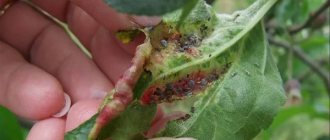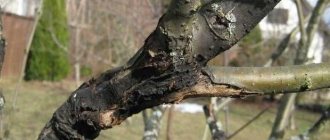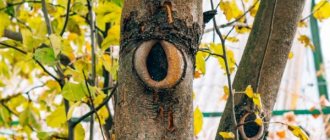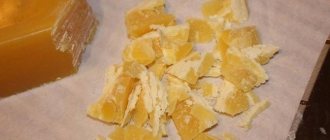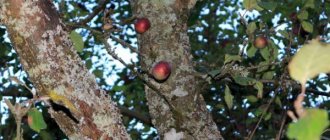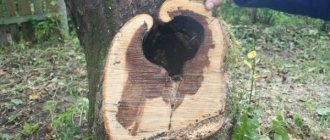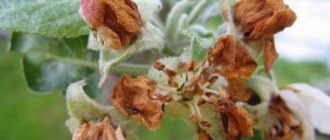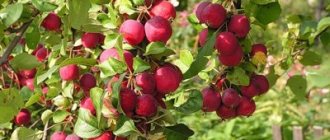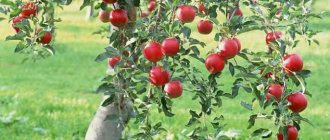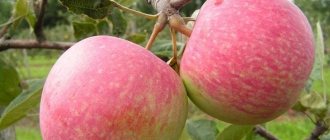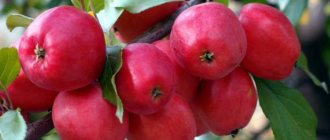Apple tree tops are strong, vertically growing fattening shoots. They usually grow larger leaves than other branches. Tops grow from dormant buds; they do not bear fruit, but thicken the crown. In most cases, they are formed when the tree is damaged or improperly pruned. It is these shoots that can be used by a gardener to rejuvenate a tree, create planting material, and graft new varieties. In this material we will analyze for what reasons tops can form, what are their features, when they need to be cut and whether it is possible to form a crown, a new branch, or seedlings from them.
How to determine that tops have appeared on an apple tree and what they look like
Tops are branches through which the tree is renewed. They appear on the apple tree mainly due to its damage, improper watering (usually excessive), the application of too much nitrogen fertilizer, and also as a result of improper pruning of the old tree.
The fact that it is the tops that have formed on the tree is indicated by a decrease in the fertility of the tree itself, as well as a slowdown in its growth.
In such cases, the gardener needs to decide as quickly as possible whether he should leave the branches or whether he needs to prepare for new pruning - sanitary or rejuvenating.
Tree damage
Fat shoots can form as a result of various types of damage to the tree. These include:
- sunburn;
- frostbite;
- mechanical damage to the cortex;
- loss of large branches - skeletal or semi-skeletal;
- lack of proper processing of large sections.
The number of fresh shoots formed will depend on how badly the plant is damaged. If the area of damage to the bark is insignificant, there will be few tops, but if the tree has been severely damaged by burns or frostbite, one can expect the formation of a large number of young shoots.
Bad trim
Tops often form on apple trees after improper pruning. The following common gardener mistakes contribute to this:
- Cutting branches to form a stump. In place of one such branch, several fatty shoots can grow at once.
- Radical pruning of a tree, in which the gardener processes all parts of the crown in one go.
You can read about how to properly prune a pear in this material.
To avoid such problems after pruning, you need to rejuvenate the tree in stages. It is recommended in the spring to cut branches from only one part of the crown (it is better to start pruning from the south), and after 4 years cut the other. In this case, you need to do pruning with the formation of small wounds on the tree and be sure to treat the cuts with garden varnish.
How to propagate an apple tree: all effective methods with descriptions
Apple trees are perhaps the most numerous inhabitants of Russian gardens. And every individual amateur gardener, no doubt, has his own favorite variety of apple tree that he would like to have on his farm.
And sometimes you need to renew your plantings, but you don’t want to lose a variety of apples dear to your heart.
Then the gardener is faced with the question of how to propagate an apple tree? In this article we will look at the most popular methods of propagating apple trees, noting the advantages and disadvantages of each method.
How to propagate an apple tree by seeds
This method is not very popular among amateur gardeners. Rather, it is used by professional breeders in cases where new varieties are developed. This is due to the fact that in the vast majority of cases, a plant grown from seeds does not receive maternal characteristics, and will rather be a wild apple tree.
It is possible for such a plant to bear fruit, but it is impossible to predict what the apples will taste like. It is advisable to use such trees as a rootstock, but they will begin to bear fruit in 7-9 years. But such seed rootstocks grow quite tall, they are not whimsical and high-yielding.
To obtain seeds with as many cultural traits as possible, you need to take the flowers of two plants and “exchange” their pollen. The seeds obtained from such a mixture will receive the characteristics of both plants.
However, it’s a pity, but not all the characteristics of the “parent” plants are preserved, and the process of cross-pollination is quite labor-intensive.
Therefore, it most likely does not make sense to use this method of propagating apple trees on your site.
How to propagate an apple tree from cuttings
This method can be divided into two subtypes
Using cuttings as scion
To do this, you will need cuttings prepared from young shoots (first year). They are cut from the tree exactly on the day on which the grafting is scheduled. In the future, the cuttings will not be suitable for use. Therefore, take exactly as many cuttings as you plan to use that day.
All foliage must be removed from the cuttings and grafted onto the roots of the rootstock. In this case, the grafting site does not need to be covered too much with soil. Otherwise, the cutting may develop independent roots and the grafting will fail.
In this case, wild ones are ideally suited as a rootstock. They are unpretentious, adapted to local climatic conditions, and tolerate low negative temperatures well. In order to choose a rootstock, you need to consider:
- if the rootstock is not tall, then it is better to graft cuttings of columnar apple trees onto it.
- It is better to graft a cutting of a high-grade apple tree onto a rootstock grown from seeds.
In the northern regions of our country, where there are long and harsh winters, leading to frequent freezing of apple trees, grafting to a dwarf rootstock is also possible.
Such rootstocks are grown in specialized nurseries. They are divided into superdwarfs, dwarfs, and semi-dwarfs. When planting such a rootstock, make sure that the root collar is 4-5 cm above ground level. In this case, the grafting site will be located a few centimeters higher. The roots of dwarf apple trees need to be buried deeper than usual, and the apple tree itself must be tied to a support.
Grafting should be done with a cutting in the spring, and with a bud (using the budding method) at the end of summer.
The quality of apple trees grafted onto a dwarf rootstock will depend on the characteristics of both trees. However, we can highlight the main qualities inherent in most of them: good fruiting and a compact crown.
Among the disadvantages inherent in apple trees grown on such a rootstock:
- poorly developed roots;
- low resistance to drought;
- demands on soil composition;
- increased fragility of wood.
But if the groundwater in your garden is located very close to the ground, you can grow a whole garden of dwarf apple trees.
Propagation by root cuttings
This method is vegetative and allows you to preserve all the characteristics of the mother plant. Thus, apple trees grown from root cuttings do not need grafting.
Planting material for this method is prepared in the spring, even before the buds open, or in the fall. The cuttings should be about 20 cm long. The prepared cuttings are planted in the ground (in furrows) to a depth of 2-3 cm from the cut site. At the same time, maintain a distance of 25-30 cm between plants, and 1 m between rows.
After planting, it is better to shade the seedlings slightly and cover the ground with a layer of mulch, such as humus. Don't forget to water your plantings regularly. Rooted seedlings can be transplanted to a permanent place in the fall.
Is it possible to propagate an apple tree using root suckers?
This method is not very popular, since only a rootstock grows from the root suckers, onto which the desired variety is grafted in the future.
In order to obtain root offspring, you need to select a mother tree. It should be quite young and healthy, with good fruiting. The selected tree is trimmed a little and dug up, covering it with soil. After some time, root shoots appear. The most suitable for transplantation are the offspring located at some distance from the mother tree.
Young offspring can be separated and planted in a permanent place at the age of 1-2 years in spring or autumn. Only root shoots with developed roots are suitable for transplantation.
Among the disadvantages of this method, it should be noted that it greatly weakens the mother tree, and the offspring do not take root well in a new place. And among the advantages we can highlight the fact that the method of root shoots allows you to obtain several seedlings of the variety you are interested in at once.
How to propagate an apple tree by layering
This method is essentially similar to the propagation of shrubs by bending down and rooting branches. The scheme of action in this case is approximately the same.
The branches of the first year of life are cleared of leaves at a height of 25-30 cm from the top. In the place where the shoot will touch the ground, make a hole, fill it with a mixture of sand and garden soil, bend the branch and secure it.
The crown of the shoot needs to be tied up so that the formation of the seedling proceeds vertically.
Once the cutting has formed its own root system (usually during the summer months), it can be divided from the mother plant and planted in a permanent location. Or you can first place the cuttings that have given root in a flower pot and grow them at home for a while. Then the process of acclimatization of the plant in the future will be much easier.
The disadvantage of this method is the fact that, unlike shrubs, tree branches grow high from the ground, which makes them difficult to bend down. In addition, the total time from bending down to rooting in a permanent place of a new plant takes about six months.
On the plus side, you can bend branches for rooting not only in the spring, but throughout the year (except for the flowering period and hot and dry days). In addition, the resulting seedling does not need grafting and carries all the qualities of the mother plant.
Propagating a tree with a broken branch
In principle, this is the same method of propagation by layering. It can be carried out in two directions.
In the first case, they take shoots of the first year of life and dig them into the ground, deepening them by 10 cm so that the above-ground part is 30-40 cm in length. The branch is tied to a support. During the entire growth period, the seedling is watered and weeded. After about a year, the branch will take root and can be planted in a permanent place (it is better to do this in the fall).
In the second case, the bark is cut off on a selected branch at a distance of 10 cm from the growth point, and the cut site is treated with a root formation stimulator. Then the cut is wrapped in a material that holds moisture well (moss, for example), and on top with a film. After roots have formed, the branch can be transplanted to a permanent location.
Seedlings obtained in this way retain all the characteristics of the mother plant, and fruiting occurs after 3-4 years.
Cloning as a method of apple tree propagation
This method is becoming more and more popular.
In a laboratory, cloning is carried out by placing cells in a special nutrient medium. These cells are then exposed to a specific set of hormones. As a result, a clone grows - an exact copy of the mother plant.
It only takes one winter to grow an apple tree. And in the spring the apple tree can be planted in the ground. Moreover, the number of copies that can be grown as a clone is not limited in any way.
The disadvantages of this new method are its high cost, as well as the high probability that the new plant will be difficult and long to “over-harvest”, since it was grown in sterile conditions and lacks immunity.
At home, cloning is vegetative propagation that preserves all the varietal properties of the mother trees. Cloning by root suckers is possible. They are easily separated from the mother plant and have a high survival rate. The resulting trees begin to bear fruit after 4 years and produce good harvests.
It is also possible to root low-growing branches. To do this, you can place a container with soil under the branch that you plan to root.
Scratches are made on the bark of the selected branch, in a place determined for the development of the root system.
These scratches are treated with a root formation stimulator, and then the branch is bent to a container with soil, secured and covered with earth. As a result, roots should form, this will be a cloned layer.
How to propagate an apple tree by air layering
The most widespread method of propagating apple trees. To use it you will need woody shoots. At a height of 20-30 cm from the growth point of the shoot, you need to remove all foliage and cut off the bark a little in a circle.
The cut is treated with a root formation stimulator, wrapped in a material that retains moisture (moss works well), and on top with film or insulating tape. Over time, roots will form at the cut site.
And the seedling can be separated from the mother tree and planted in the ground.
In conclusion, it must be said that propagating an apple tree of your favorite variety is not so difficult. In addition, as described above, it is not at all necessary to do labor-intensive vaccinations that require a lot of experience. Just choose one of the vegetative methods that are more suitable for you and go for it!
Source: https://ogorodnash.ru/kak-razmnozhit-yablonyu/
Are tops fruity?
Tops are elongated vertical non-fruit-bearing branches, used primarily for tree renewal. They differ from fruit-bearing branches not only in the direction of growth, but also in the shady type of leaves, as well as in the looseness of the wood and increased water content.
If they are formed in large numbers, such branches can deplete the tree. That's why they need to be cut off.
For this reason, they prefer to be cut off. However, experienced gardeners can use tops to form new fruiting branches and roots, depending on the condition of the tree. To do this correctly, you need to know how to distinguish a top from other branches, and how it can be used.
How to distinguish between a fruit branch and a top
Tops have a number of differences from fruit branches. Among them the following should be highlighted:
- rapid growth;
- vertical placement of shoots (forked tops can have a horizontal part);
- absence of fruit buds along the entire length of the branch;
- the presence of larger leaves on fat shoots than on fruit branches.
Tops can grow denser than ordinary fruit branches. If they form after unsuccessful pruning of an apple tree, up to five tops can grow from one old cut branch. Because of this, such shoots can thicken the crown of any type of apple tree in a short time.
What are fat shoots
Fat shoots are young vertically growing branches of an apple tree that are used to restore the tree, but do not participate in fruiting. If necessary, these shoots can be transferred to any other type of branch. To solve these problems, gardeners use simple agrotechnical measures.
Virtually any part of the tree can develop from fatty shoots. If necessary, not only branches, but also roots can be formed from them. It all depends on the tree restoration tasks set by the gardener.
Are they fruitful?
Tops on an apple tree are intended exclusively for restoring the tree in case of damage to the main branches or pruning. Their intensive growth excludes the possibility of fruiting of such shoots. Fruit buds do not form on them, therefore, there cannot be fruits on such shoots.
Spinning tops can be forced to bear fruit under certain conditions. To do this, you can cut such a shoot for fruiting or bend it so that it grows horizontally. However, it is recommended to do this only in cases where there are few fertile buds on the tree, since it is still more advisable to leave the tops to renew the tree.
How to delete
There are no exact dates for pruning, because shoots appear at different times. The right moment for the procedure is when the tops on an apple tree or other tree grow up to 20 cm: they are not yet strong, and after pruning there will be no large wounds left. To work use:
- loppers, garden shears or pruning shears are ideal tools for trimming growth about 1 m long;
- hacksaw - suitable for strong, tops that cannot be removed by hand;
- resins and construction paints, garden varnish (you can mix 500 g of tree resin, 60 ml of medical alcohol with 2 tablespoons of linseed oil) - treat the cuts with these products to protect them from moisture and infections.
Proper pruning of tops
Green, fragile shoots can be broken off by hand. If you leave such shoots, then after a year you will need pruning with a special tool:
- Cut/file down the tops at the base to prevent them from re-growing.
- Treat wounds with antiseptic agents - apply paint, resin or garden varnish.
What to do to get rid of them
The formation of tops on a tree cannot be left to chance. It should be remembered that they can overload the crown, which not only leads to a decrease in productivity, but can also provoke the appearance of parasites and diseases on the tree, which in turn can provoke the death of the apple tree. Therefore, most tops should be removed after they appear. To do this, it is best to break out the shoots by hand before they reach a length of 15 cm; this can be done at any time of the year.
They can form not only on the crown of the tree, but also in the root part.
At the same time, there are a number of situations in which the tops need to be left. They are used to rejuvenate trees and graft new varieties. Popular varieties for grafting include Bogatyr and Champion.
When should they be cut down?
In many cases, tops on trees need to be trimmed. Shoots are removed under the following conditions:
- If the fat branches grow strictly vertically.
- If the shoots are directed inside the crown. This is the main indication for removing young fatty shoots.
- If young shoots heavily overload the crown. This can lead to a decrease in tree productivity and the appearance of lichen on the bark.
In all of the above cases, pruning of tops can be carried out at any time of the year, even during the growing season of the apple tree. It is recommended to cut them into rings - this will not damage the apple tree and will not affect its fruiting in any way.
When to leave
Tops can be left on old trees. They do this in the following cases:
- If you are going to carry out anti-aging pruning of the tree in the coming year. In this case, the tops are left to form new fruiting branches.
- If a gardener needs to graft a bud or cuttings of a different variety.
- If you need to make additional fruit branches.
Even with such tasks, the gardener needs to decide in advance which tops he will leave for further work and which ones he will not need. It is recommended to remove all unnecessary vertically growing branches during the next pruning so that they do not interfere with working with the crown.
Reasons for appearance
Some gardeners do not know what can cause spiny shoots to appear on trees. There are several main reasons that contribute to their occurrence:
- Damage to the crown due to strong gusts of wind, frequent snowfalls or other natural disasters. When apple trees are seriously damaged, the tops begin to grow to replace the dead branches and restore the normal state of the plant.
- The development of black cancer and the appearance of dark spots. Pathology leads to drying of the leaves and death of the branches. The spiny stems grow back to form an intact crown.
- Deep planting of apple trees. Often, due to deep planting, tops appear in the lower part of the trees. To remove them, you will have to remove the top layer of soil to get to the base of the shoots and cut them off.
Answers to frequently asked questions
There are quite a lot of questions and prejudices associated with tops that can bother even experienced gardeners. They concern processes such as crown formation, creation of additional fruit-bearing branches from healthy shoots, tree rejuvenation, formation of seedlings and planting of shoots.
All the problems presented can be solved with the help of tops if you follow all the recommendations on agricultural technology and carry out certain gardening work in a timely manner. Incorrect treatment of fatty shoots will not only not give the desired result, but can also greatly harm both young and old trees.
Is it possible to form a crown from them?
Tops can be used to form a new crown of an apple tree after pruning. To do this, you should first outline the branches that you will work with, remove excess tops, and then tilt the branches using weights so that they are positioned horizontally. After the tops take on a new direction of growth, they will need to be pruned into several buds.
It should be remembered that those tops that continue to grow vertically even after pruning will not produce a harvest. Only branches located horizontally bear fruit. These processes are associated with the peculiarities of the outflow of photosynthesis products from the green part of the tree.
Make a branch: wake up and resuscitate
Although the tops themselves do not bear fruit, they can be used to make ordinary fruiting branches. You need to work with them like this:
- To begin with, the branch is given a horizontal position. To do this, a load is placed on it (for example, bottles of water) and left for three months.
- After this, a third of the branch above the developed bud is cut off and treated with garden varnish. With proper pruning, lateral shoots form on the branch very quickly.
- If the top has a forked tip, one of which grows horizontally, the vertical part is cut into a ring, after which the horizontal part is trimmed by a third. Weights are not used in this case.
With proper pruning, the new branch will begin to bear fruit the next year. If this does not happen, it means that the gardener made some mistakes while working with the tree.
Rejuvenate an old apple tree in the spring: how to distinguish a growth branch and get rid of a top one
Tops can be used to rejuvenate apple trees. To update such a tree, proceed as follows:
- In the spring, before flowering begins, the apple tree is inspected. If there is no significant damage or signs of disease, proceed to spring pruning.
- Initially, branches are removed at the height of the third tier.
- After this, the side branches are cut back to the recommended height level. Only small shoots and semi-skeletal branches are pruned.
- Wounds formed at the cutting sites must be disinfected and treated with garden varnish.
You can read about pruning apple trees in spring here.
After such pruning of the old ones, the gardener will need to monitor the formation of new fatty branches and make fruit ones from them. If a large number of young tops appear, pruning will have to be done again.
Make seedlings
Tops are often used to create seedlings, regardless of the type of apple tree.
They work with them like this:
- Choose the strongest shoot. Notches are made on the bark at its base.
- The damaged area is treated with agents that promote the formation of roots (for example, “Kornevina”). The incision site is wrapped in film or covered with moss.
- By autumn, roots form on the branch, the shoot itself is cut off and transplanted into the garden.
- Making apple tree rootstock.
You can read about how to root an apple tree branch at the link.
Seedlings formed in this way have a high survival rate. They are used for grafting apple trees, as they quickly take root and become covered with bark.
How to remove fat shoots
Fat shoots can be planted as a full-fledged seedling. To do this, it is necessary to air-layer the root in the spring, or it may burst and dry out; in the fall, cut off the finished seedling with pruning shears and transplant it to a previously prepared place. Air-layering of a plant involves removing the bark from a young shoot at a distance of 25 cm from its top and covering this place with an opaque film for the formation of young roots.
You can read about the scion of an apple tree in spring in this article.
For self-rooted apple trees, root tops can be used to grow new trees. They are cut off, or you can get rid of them, or they are transplanted to another area. Only the roots of grafted plants are not taken for this purpose.
Pear pruning technology
All work related to pruning fruit trees and shrubs is carried out with sharply sharpened and adjusted tools. The knife should be razor sharp. Any tool should leave an even cut without crushing the bark and cambium. All wounds should be covered with garden varnish.
The purpose of pear pruning is to prevent thickening, increase productivity, and form the crown. There are:
- spring formation;
- pruning tops during flowering;
- autumn processing of pear trees.
In the spring, as soon as the ambient temperature becomes +5 0, it’s time to start pruning the pear. How young seedlings are formed can be seen in the diagram. But in the future, as the tree matures, annual pruning of branches is necessary, since fruit buds are formed during growth. Early pruning promotes high pear yields. As a result of pruning a pear in the spring according to the following scheme, the tree directs nutrition to flowering and fruiting:
- All fattening branches are removed. Each branch in the tier receives maximum heating and lighting.
- Limiting upward growth is achieved by shortening the trunk by a quarter of last year's growth.
- Do not leave open cuts; use garden varnish.
- Branches growing in the wrong direction, that is, not horizontal to the ground, are removed.
In the spring, rejuvenating pruning of a neglected tree is carried out, but only partially. It can be carried out at zero temperature. It is impossible to remove all the thickets at the same time; the tree will die. The process should be extended over 3-4 years.
After the leaves appear and before harvesting, tree care is considered summer. In summer, caring for the crown consists of plucking out the young tips of the branches that have not yet become lignified. They are easy to remove without damaging the pear. The wound heals instantly. It is pinching or tweezing that is considered pruning a pear in the summer. During sap cutting, it is only possible to inflict wounds on the tree with pruning shears or a knife in extreme cases.
After harvesting, the tree must be prepared for winter. Experts believe that for early and middle varieties, only sanitary pruning is allowed in the fall. For late pears, you can gently prune the tops in the fall in October. Later, the tree may be weakened and receive frost damage.
The pear tree will strive to close the wounds received during pruning, while using up the reserves of vitality needed in winter. In autumn, if the branch is removed, then the stump is not left in the ring.
Regular pruning of pears, removal of tops, shortening of the central shoot is a necessary agrotechnical technique aimed at increasing yields and preventing diseases.
conclusions
- Spinning tops/spinning tops (spinning tops can be identified/look like by seeing red/red caps on a branch) are fast-growing fatty growth shoots located vertically on a tree, here's how to identify them.
- They do not have fruit buds and do not produce a harvest, but can be used to restore a tree after pruning.
- Most tops are cut off; cutting them down is a necessity. Only those shoots are left that they plan to use in the future to form a crown, fruitful branch or seedlings.
- To form fruitful branches from tops, the latter need to be tilted horizontally to the ground using weights that can weigh quite a bit, and then cut to a third of the length above a large bud. Already the next season after such treatment they can begin to bear fruit, i.e. It will be possible to resuscitate them and wake them up, the buds will wake up and begin to swell by spring.
Read about how to properly prune an apple tree here.
Deadlines
In autumn, it is recommended to start pruning when all the leaves have fallen from the trees. To perform the procedure, you need to choose a dry and clear day with a positive temperature. If the temperature drops to minus 5 degrees, pruning is strictly prohibited. In frosty weather, injuries to apple trees increase due to the fact that their branches become fragile and brittle.
In autumn, pruning of apple trees is allowed in almost all regions. The procedure in the southern regions and in areas with a temperate climate is carried out after waiting for the leaves to fall. The whole of September and the first 10 days of October can be used for pruning in the northern regions.
After pruning, the tree should have enough time for the wounds left from the procedure to heal.
Late varieties of apple trees in areas with harsh climates should be pruned in spring.
By region
In different climatic regions of the country, tree pruning in the fall is performed in approximately the same way. The only difference in the formation of the crown is that in harsh climatic conditions it should be located lower than in areas with a warm climate.
But the completion times vary slightly. Each specific location has its own optimal dates for performing this procedure. Let's see when gardeners in the regions start pruning apple trees in the fall.
- Siberia and the Urals. In these areas, great care is taken when pruning apple trees in the fall. Cuts do not always have time to heal before the arrival of frost. tissue damaged by frost may become dead. It is better to carry out this work in the spring.
- Middle zone and Moscow region. Work is carried out from mid-September to October 15.
- In the south of the country. In the regions and territories of southern Russia, the pruning procedure for apple trees is carried out during October and ends until mid-November.
- European part of Russia. In this area, the autumn pruning procedure is carried out from October 15 to November 5.
- Ukraine, Belarus. In these countries, pruning of apple trees in the fall is planned for September - October.
- Leningrad region. Tree pruning in the region begins in the fall after leaf fall, which corresponds to approximately mid-October. The work must be completed before the November holidays.
- Eastern Siberia. In these endless Siberian regions, pruning is carried out from the beginning of September to the end of the first ten days of October.
- Far East. Apple trees are also successfully grown on the eastern outskirts of vast Russia. They are pruned there from August 25 to September 15.
Apple trees, like other plant organisms, depend on lunar cycles in their development. If you are used to being guided by the lunar calendar when performing gardening work, then do the pruning on the waning Moon. Wounds received by the apple tree during pruning during this period heal quickly because sap flow is minimal.
There is no need to prune apple trees during the full moon or new moon, otherwise the plants will become sick for a long time after that. Pruning carried out during the waxing Moon leads to severe stress on the trees, which is also very bad.
Thus, when determining the day for pruning, it is necessary to take into account the season of the year, air temperature and phase of the moon.
Favorable days for autumn pruning in 2021 according to the lunar calendar should be considered:
- September: 1, 6–7, 15–16, 26–28;
- October: 2–5, 8, 12–13, 25, 29–31;
- November: 4–5, 9–10, 25-28
It is highly not recommended to prune on such days:
- September: 2, 9, 25;
- October: 1, 9, 24;
- November: 1, 7, 23.
Fruit trees are pruned at different times of the year - spring, summer, autumn, winter. The apple tree begins to be pruned at the time of planting and the procedure is carried out throughout the life of the plant.
An apple tree is considered young when it is under five years old. It is pruned to create the correct crown shape. Over five years, from 2 to 4 tiers are formed on the apple tree. The crown of the tree is shaped so that it is easier to care for and collect fruits.
Often the weather disrupts the time when apple trees are pruned. Early arrival of frosts, strong winds, a lot of snow - this can interfere with autumn pruning. In such cases, the formation of the apple tree crown is postponed to spring.
If the winter was warm and with little snow, then pruning can be done in winter. This should be done very carefully.
In frosty weather, tree branches become very fragile, break easily and form lacerations. They do not heal at sub-zero temperatures.
Due to changes in night and day temperatures, the bark cracks even near neat cuts. This can lead to damage to important skeletal branches and the trunk of the apple tree.
If you still decide to take a risk and prune in winter, be guided by the weather forecast.
Attention! It is recommended to work with trees only at temperatures that do not fall below -3°C on the day of pruning and for several days after.
There are different times when apple trees of different ages are pruned:
- Young trees adapt more easily to weather conditions and their wounds heal faster. Therefore, for them the question is “when should you prune apple trees in the garden: in autumn or spring?” irrelevant. Their crown can be formed in autumn, spring, and even in winter when there is a thaw;
- For mature fruit-bearing trees, any intervention is stressful, so rejuvenating or regulatory pruning is best done in the spring, before the buds open.
Pinching fruit trees and bending branches
Special techniques are an alternative or complement to pruning. They are not difficult to complete, but you will need to know thoroughly what you want to get in the end, and have “three-dimensional thinking”, see the crown in volume - the one that is, and the one that will ultimately be. And, as in the case of pruning, if in doubt, it is better not to do it.
Pinching, also known as pinching, is the removal of the top of a growing young shoot—the annual growth. This is done when the shoot is still green, and the top is easily broken off with your fingers - in the place where you decided to limit the growth of the shoot. Usually they pinch off above the third to fifth true leaf, when the length of the shoot is about 1-5 cm. The optimal time for pinching is when there are 2-3 weeks left before the end of shoot growth, in the middle zone this is approximately mid-July. A completely similar action is performed when shaping tomatoes, cucumbers and some houseplants - so it is quite possible that you are already familiar with this technique.
It happens that after pinching the axillary buds begin to grow. If the shoots growing from them are short, these are future overgrowing branches, do not touch them, but long shoots must be pinched again.
If in some place of the tree there is a strong bud from which a branch will develop, but in this place the branch is not needed, then the bud can be blinded - plucked out with your fingers along with the weaker dormant buds located at the base. Do not injure the bark; it is better to blind the dormant buds when they begin to grow.
Thus, you can level the emerging crown of a young tree or use these techniques when forming artificial crown forms. Due to the size of mature trees, these techniques are of limited use.
Growing tops can be broken out with your hands or a stick with a hook (even a hook available on the farm will do) - since the growth processes are still ongoing, the wound will quickly heal. It is easiest to break out the tops when they do not exceed 1-5 cm in length; then it is better to use pruning shears, since the likelihood of scuffing the bark increases. Tops are easily recognized by their vertical growth and lighter and often larger foliage. After removing the tops, sometimes new tops develop from dormant buds in the same place - they will also have to be removed.
If the tree is still young, then it has few branches and, accordingly, leaves. Working hard with pruners will deprive the tree of foliage, and, consequently, reduce the area for photosynthesis and worsen nutrition. Therefore, it makes sense to cut out unnecessary branches of a young tree in parts, and at first only limit their growth. In addition, the branches coming from the trunk contribute to the formation of a trunk that gradually expands downward, which increases the mechanical strength and stability of the tree.
Bending back branches of fruit trees is an alternative to removing branches in some cases. If only a branch directed at an ugly angle is looking in the right direction, you can try to correct the situation. If the angle of departure of the branch from the trunk is very sharp, then it is better not to risk it and cut the branch - with a high probability it will simply break and not bend back. The branch is fixed at the desired angle for one or two seasons. If you bend back the branches at the end of growth, when lignification begins, then one season is usually enough.
The fastening must be free, with allowance for thickening of the branch, so soft material must be placed under the ropes and wires - for example, pieces of rubber. Please note that over the course of a season, the branch increases in diameter by about a centimeter, and a tightly tightened rope bites into the bark and can literally strangle the branch in one season. It is better to remove all fastenings for the winter and put them back in the spring.
If the branch is still young and flexible, but remains thick, then in the lower part of the bend you can make several parallel cuts about a third of the diameter - this will help bend the branch, and the wounds will quickly heal. Thick branches that have lost their elasticity cannot be bent. It should be taken into account that if the limb turns out to be “humpbacked”, then in the upper part of the “hump” there will be the best conditions for feeding the buds, and it is here that strong and powerful vertically directed tops will grow. In some cases, this is advisable - you grow a strong shoot in the part of the crown where it is necessary, and then remove part of the “mother” branch by pruning for transfer - to a young and strong shoot.
Creeping apple tree: pruning
Pruning a creeping apple tree has its own subtleties. This procedure is carried out mainly in the spring. Be sure to remove all branches that show signs of disease or have dried out over the winter. Autumn and summer are the time to control the growth of green mass. The crown should not be allowed to thicken. Even a young shoot located at an acute angle to the main trunk must be cut out.
creeping apple tree
Formative pruning of a creeping apple tree involves a horizontal arrangement of shoots that form the crown. The inclined branches must be directed to the sides so that they, with the free space, are directed in strictly opposite directions. Those shoots that extend from the base of the trunk are deflected in the other direction relative to its growth and pinned. Constantly growing shoots are pinched near the fourth leaf, thereby turning them into fruit branches.
Pruning fruit trees to improve fruiting
To “persuade” a lazy branch to please you with fruits, there are several ways.
The first is to limit height growth by pruning fruit trees for fruiting, shortening a branch to a bud or branch directed in the desired direction.
The second way is to bend the branch (it is not at all necessary, and often undesirable, to a horizontal position, but at a minimum, the position of the branch must be made vertical). To do this, you don’t have to resort to pruning fruit trees to improve fruiting, but use stretchers - they should secure the branch in the desired position, but not injure the bark. You can hang a weight on a branch - our ancestors “threatened” non-fruit-bearing trees by hanging an ax or various heavy objects in the crown in order to “disgrace” the lazy tree (and they always added verbal intimidation in the style of “if there are no fruits, I will cut them down!”). The branches assumed a more horizontal position, due to which the balance of plant hormones changed and fruiting accelerated.
But if the whole tree is “lazy,” then it makes sense to first check how correctly you are caring for it, and also turn to reference books: perhaps you just have one of the old varieties, which are characterized by a late onset of fruiting. Thus, modern early-fruiting varieties of apple trees begin to bear fruit at 5-6 years, and such popular ancient varieties as Grushovka and Belyi Naliv produce their first fruits at the age of 10-12 and even 15 years, being already large trees. In such cases, pruning is needed to form a beautiful and regular crown, but it will not speed up fruiting.
On the other hand, if it is necessary to stimulate the growth of a specific branch of a young tree, it is “pulled” to the trunk or large branch located above.
This video shows the correct pruning of fruit trees to improve fruiting:
- Author: admin
Rate this article:
- 5
- 4
- 3
- 2
- 1
(5 votes, average: 1.8 out of 5)
Share with your friends!

